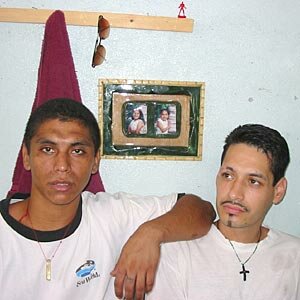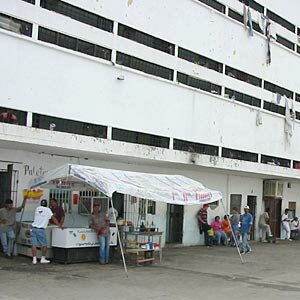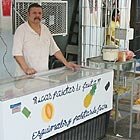
American citizens Frank Munoz, left, and Julio Camacho in the cell they share at the Nuevo Laredo prison known as CERESO I. On the wall between them is a picture of Camacho's two daughters. Photo: John Burnett, NPR News
|
June 25, 2002 -- Every year, a handful of American citizens have the bad judgment, or bad fortune, to land in Mexican prisons. An international agreement allows American citizens to transfer to a U.S. federal prison to serve out their sentence.
But for the months or years they're behind bars in Mexico, waiting for a transfer, they find prison life to be a world away from prisons north of the border. And some Americans choose to serve their time in Mexico, rather than the United States.
NPR's John Burnett recently visited the Central Facility for Social Rehabilitation in Nuevo Laredo, Mexico -- just a few miles across the Rio Grande from Laredo, Texas -- and reports for All Things Considered.
There are sharp differences between American and Mexican jails. In many ways, Mexican jails are much worse. According to a recent report by Human Rights Watch, prisons in Mexico's penal system are massively overcrowded and falling apart. The guards and prison officials are, for the most part, poorly trained and vastly underpaid. Corruption is rampant and the system has a serious lack of funds.
Prison authorities here assert that conjugal visits are the main reason male-on-male rape is rare inside their lock-ups. Convicts pay $10 a night to an inmate cooperative that keeps the "all-night visitation cells" clean, and curtained.
But unlike American prisons, prisoners in Mexico are often given an extraordinary amount of freedom within the walls. Children come to visit their fathers, wives and girlfriends can sometimes stay overnight for conjugal visits, and prisoner-run taco stands and concessions are common. In some ways, the inside of a Mexican jail is similar to a small village -- "helping reduce tensions in the prison and easing transition to the outside," according to the Human Rights Watch report.

The central courtyard of CERESO I. The cells stacked above have small slits for windows. Photo: John Burnett, NPR News
|
The Nuevo Laredo prison, known by its acronym CERESO I, was meant to house 300 prisoners. Today, more than 1,200 men are packed inside the white- washed walls. Twenty-three of the prisoners here are Americans, convicted of smuggling drugs, weapons or people.
Inmates are allowed to buy a little comfort. Some prisoners split the $200 monthly rent to live in cells with their own toilet and shower. Convicts can buy small refrigerators, stoves, fans, and TVs -- cable is available, for $30 a month. Some individual cells even have window- unit air conditioners.
CERESO I was meant to house 300 prisoners. Today, more than 1,200 men are packed inside the white- washed walls. Twenty-three of the prisoners here are Americans, convicted of smuggling drugs, weapons or people.
Prison authorities here assert that conjugal visits are the main reason male- on-male rape is rare inside their lock- ups. Convicts pay $10 a night to an inmate cooperative that keeps the "all- night visitation cells" clean, and curtained.

Paleteria La Loma, an ice cream stand operated by CERESO I inmates. Photo: John Burnett, NPR News
|
At CERESO I, prison administrators allow the inmates to create their own miniature cash economy. The prison has five privately operated snack bars. Most of the American prisoners are lucky enough to have relatives send them money -- but poor inmates have to earn money inside the prison by shining shoes, washing clothes or doing odd jobs.
Despite the humanizing quality of Mexican prisons, most Americans Burnett met serving time at CERESO I can't wait to leave. Almost all are awaiting transfers to air-conditioned U.S. federal prisons.

An inmate and child at a snack stand inside CERESO I. Photo: John Burnett, NPR News
|
The few Americans who choose to do their time in Mexican prisons usually do not make that choice based on the amenities. In Mexico, certain crimes carry shorter punishments. One of the prisoners Burnett met, Oklahoma native Matt Johnson, was convicted of homicide in Nuevo Laredo. In Mexico, he faces 5 to 8 years behind bars. He says if he transferred his case to the U.S. system, a murder conviction would likely carry a much longer sentence.
|